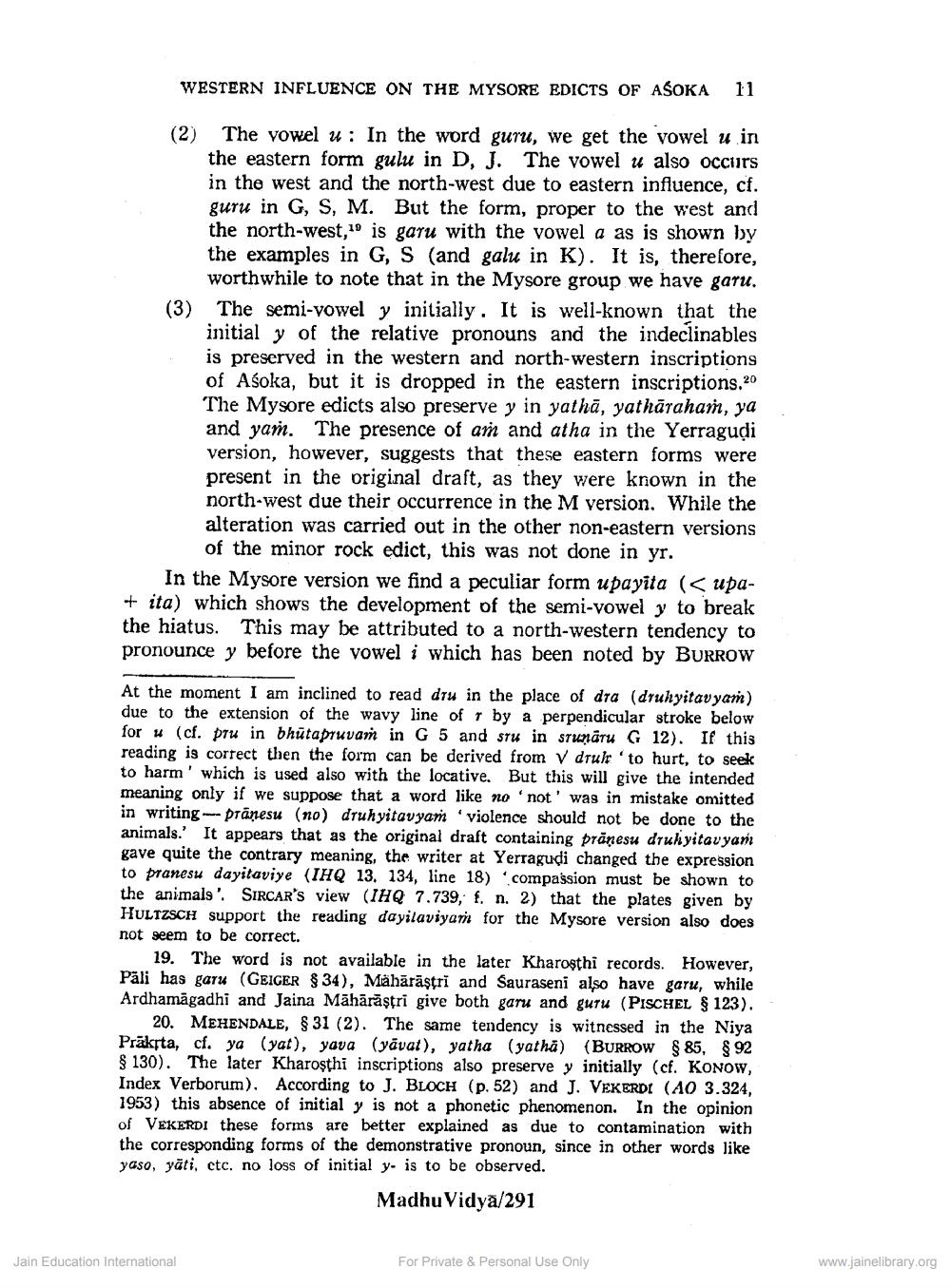________________
wesTERN INFLUENCE ON THE MYSORE EDICTS OF ASOKA
11
(2) The vowel 4: In the word guru, we get the vowel u in
the eastern form gulu in D, J. The vowel u also occurs in the west and the north-west due to eastern influence, cf. guru in G, S, M. But the form, proper to the west and the north-west, 19 is garu with the vowel a as is shown by the examples in G, S (and galu in K). It is, therefore,
worthwhile to note that in the Mysore group we have gatu. (3) The semi-vowel y initially. It is well-known that the
initial y of the relative pronouns and the indeclinables is preserved in the western and north-western inscriptions of Asoka, but it is dropped in the eastern inscriptions.20 The Mysore edicts also preserve y in yathā, yathāraham, ya and yam. The presence of an and atha in the Yerragudi version, however, suggests that these eastern forms were present in the original draft, as they were known in the north-west due their occurrence in the M version. While the alteration was carried out in the other non-eastern versions
of the minor rock edict, this was not done in yr. In the Mysore version we find a peculiar form upayita (< upa+ ita) which shows the development of the semi-vowel y to break the hiatus. This may be attributed to a north-western tendency to pronounce y before the vowel i which has been noted by BURROW
At the moment I am inclined to read dru in the place of dra (druhyitavyam) due to the extension of the wavy line of 1 by a perpendicular stroke below for 4 (cf. pru in bhūtapruvam in G 5 and stu in srunāru G 12). If this reading is correct then the form can be derived from v drul to hurt, to seek to harm' which is used also with the locative. But this will give the intended meaning only if we suppose that a word like no 'not' was in mistake omitted in writing - pränesu (no) druhyitavyan violence should not be done to the animals. It appears that as the original draft containing pränesu druhyitavyan gave quite the contrary meaning, the writer at Yerragudi changed the expression to pranesu dayitaviye (IHQ 13. 134, line 18) compassion must be shown to the animals'. SIRCAR's view (IHQ 7.739, f. n. 2) that the plates given by HULTZSCH support the reading dayilaviyar for the Mysore version also does not seem to be correct.
19. The word is not available in the later Kharosthi records. However, Pāli has garu (GEIGER $34), Mähārāştri and Sauraseni also have garu, while Ardhamāgadhi and Jaina Māhārāştri give both garu and guru (PISCHEL $123),
20. MEHENDALE, 831 (2). The same tendency is witnessed in the Niya Praksta, cf. ya (yat), yava (yāvat), yatha (yatha) (BURROW $ 85, 892 $ 130). The later Kharoşthi inscriptions also preserve y initially (cf. KONOW, Index Verborum). According to J. BLOCH (p. 52) and J. VEKERDI (10 3.324, 1953) this absence of initial y is not a phonetic phenomenon. In the opinion of VEKERDI these forms are better explained as due to contamination with the corresponding forms of the demonstrative pronoun, since in other words like yaso, yäti, ctc. no loss of initial y. is to be observed.
Madhu Vidya/291
Jain Education International
For Private & Personal Use Only
www.jainelibrary.org




